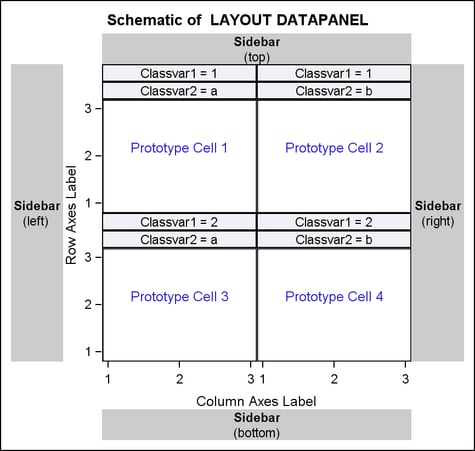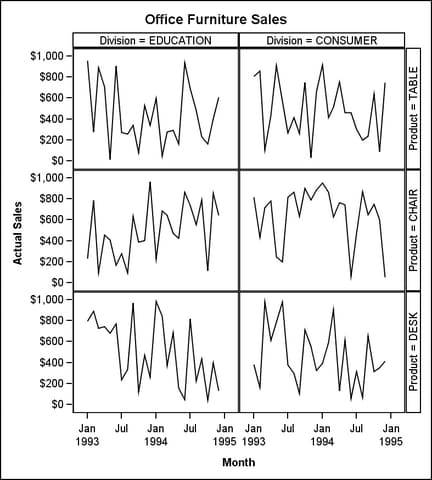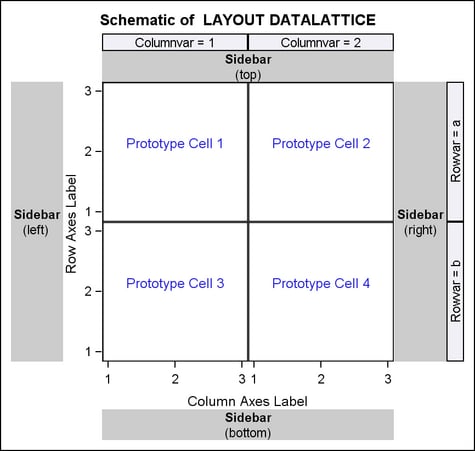Introduction
Classification Panels in the GTL
A classification
panel is a graph with one or more cells in which each cell shows a
common graph (called a prototype). The prototypes that are displayed
in the cells result from dividing input data into subsets that are
determined by the values of one or more classification variables.
GTL provides two layouts that can produce classification panels:
The LAYOUT DATAPANEL Statement
The example
in this section uses the LAYOUT DATAPANEL statement to specify a list
of two classification variables: DIVISION (two distinct values) and
PRODUCT (three distinct values). Six combinations (crossings) of these
unique values are possible, which produces a panel with six cells.
The following
template code generates Classification Panel Created with LAYOUT DATAPANEL.
proc template;
define statgraph datapanel_intro;
begingraph;
entrytitle "Office Furniture Sales";
layout datapanel classvars=(product division) / columns=2;
layout prototype;
seriesplot x=month y=actual;
endlayout;
endlayout;
endgraph;
end;
run;
In the
template code, notice the LAYOUT PROTOTYPE block, which is inside
the LAYOUT DATAPANEL block. This nested block, a required part of
the DATAPANEL layout, defines the graphical content of all of the
cells. The COLUMNS=2 setting forces a DATAPANEL layout to display
the cells in a two-column organization. The actual number of rows
that are generated depends on the number of crossings that are in
the data.
For some
data, the number of data crossings can be quite large. Thus, when
rendering the graph for a classification panel, it is common to use
a WHERE expression to limit the number of crossings:
proc sgrender data=sashelp.prdsale template=datapanel_intro; where country="U.S.A." and region="EAST" and product in ("CHAIR" "DESK" "TABLE") ; format actual dollar.; run;
The following
schematic shows the general organization of a graph that is produced
with the DATAPANEL layout. If the template code does not use the sidebar
areas that are shown in the schematic, that space is reclaimed in
the graph. Also, the order in which you specify the classification
variables affects the cell ordering. The graph that is represented
by the schematic could be produced with
CLASSVARS=(classvar1
classvar2).
The LAYOUT DATALATTICE Statement
The example
in this section uses the LAYOUT DATALATTICE statement to specify the
same two classification variables: DIVISION and PRODUCT. Notice the
following details about the LAYOUT DATALATTICE statement:
The following
template code generates Classification Panel Created with LAYOUT DATALATTICE.
proc template;
define statgraph datalattice_intro;
begingraph;
entrytitle "Office Furniture Sales";
layout datalattice rowvar=product columnvar=division;
layout prototype;
seriesplot x=month y=actual;
endlayout;
endlayout;
endgraph;
end;
run;
proc sgrender data=sashelp.prdsale template=datalattice_intro;
where country="U.S.A." and region="EAST" and
product in ("CHAIR" "DESK" "TABLE");
format actual dollar.;
run;
In this
example, the grid dimensions are automatically determined by the number
of distinct values of the classifiers PRODUCT and DIVISION.
Coding Distinction Between DATAPANEL and DATALATTICE
The primary difference between coding the DATAPANEL and DATALATTICE
layouts is the way that the classification variables are declared.
DATAPANEL
takes one list of variables in parentheses. The number of class variables
in the list is unlimited, though the effectiveness of the graph decreases
as the number of class variables exceeds three or four. In such a
case, it is better to use two class variables, and use the other class
variables in the BY statement of the SGRENDER procedure.
layout datapanel classvars=(product division) / . . . ;
DATALATTICE, on the other hand, takes one variable
for a row dimension and/or one variable for a column dimension:layout datalattice rowvar=product colvar=division / . . .;The LAYOUT PROTOTYPE Statement
In both the DATAPANEL
and the DATALATTICE blocks, the nested PROTOTYPE layout is similar
to an OVERLAY layout, with the following major differences:
-
Multiple plots can be overlaid, but BARCHART is the only computed plot that can be included in the prototype. This means that you cannot use BOXPLOT, DENSITYPLOT, ELLIPSE, HISTOGRAM, REGRESSIONPLOT, LOESSPLOT, PBSPLINE, or MODELBAND statements in the PROTOTYPE layout. See Using Non-computed Plots in Classification Panels for examples of how to work around this limitation.
-
DISCRETELEGEND, CONTINUOUSLEGEND, and ENTRY statements cannot be included in the PROTOTYPE layout, nor can nested layouts. For information on adding a legend or other information outside of the cells, see Using Sidebars.
-
Axis options for classification panels are specified on the LAYOUT DATALATTICE or LAYOUT DATAPANEL statement, not on the LAYOUT PROTOTYPE statement. For information on setting axis options for the layout, see Setting Panel Axis Features.



